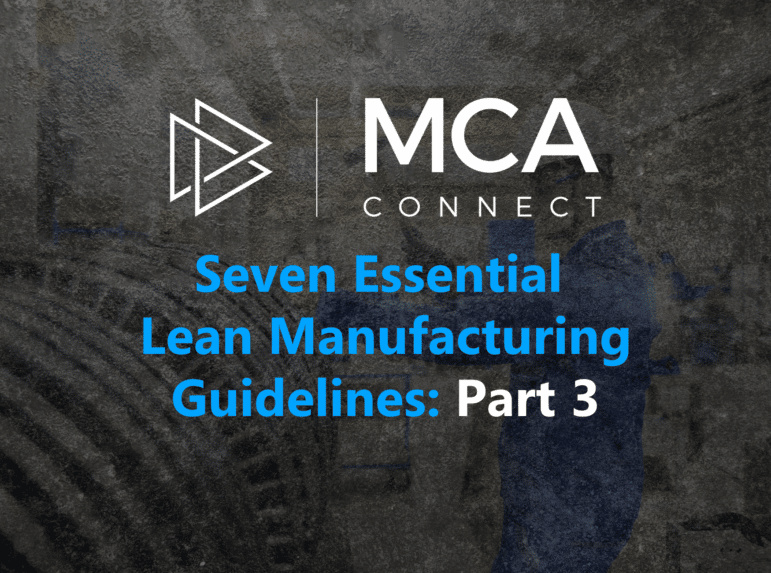Welcome to part three of our blog series, ‘Seven Essential Lean Manufacturing Guidelines’. All manufacturers know that lean manufacturing is an essential component of manufacturing excellence. This three-part blog series will outline seven essential guidelines for manufacturers to consider during the design of a future state value stream. These guidelines include:
- Produce to your takt time.
- Develop continuous flow wherever possible.
- Use supermarkets to control production where continuous flow does not extend upstream.
- Send the customer schedule to only one production process.
- Level the production mix by distributing the production of different products evenly over time at the pacemaker process.
- Level the production volume by releasing and withdrawing small, consistent increments of work at the pacemaker.
- Develop the ability to make “every part every day” (then every shift, then every hour, or pallet or pitch) upstream of the pacemaker process.
Part 1 of the blog series covered guidelines 1-3 and can be found here.
Part 2 of the blog series covered guidelines 4-5 and can be found here .
In this post, we’ll discuss leveling the production volume by releasing and withdrawing small, consistent increments of work at the pacemaker. We’ll also cover developing the ability to make “every part every day” (then every shift, then every hour, or pallet or pitch) upstream of the pacemaker process.
6. Level the production volume by releasing and withdrawing small, consistent increments of work at the pacemaker.
With this guideline, we get to talk about perhaps the least known of lean principles – pitch. Our goal is to release work to the pacemaker processes in small increments and then manage each schedule to ensure completion.
Understanding the Pitch Process
Pitch is the lean term for the consistent increment of work released to production. The pitch period is the length of time that the increment of work covers. The value of pitch is to set the time frame for management feedback and reporting. If you release work with a pitch period of a week, you’ll only know at the end of the week whether you achieved your week’s production. If you release work daily, you’ll know day by day but not more frequently than that. If you release by shift, each shift can know if they are ahead or behind. Better yet, if you release with four-hour, two-hour, or even hourly pitch, you can know if you are ahead or behind much more frequently. The more frequently that you can monitor your production progress, the shorter your response time to issues is that may impact your delivery to customers.
The broader concept is called fixed interval scheduling. With fixed interval scheduling, work is released to all operations in a consistent rhythm with all work linked to each schedule to track start and end time. Schedules produced for each pitch period must be confirmed to have available capacity and available material. With short pitch periods, scheduling can be very dynamic.
7. Develop the ability to make “every part every day” (then every shift, then every hour, or pallet or pitch) upstream of the pacemaker process.
The last of the seven guidelines for designing a lean future state is to develop the ability to make “every part every day” (then every shift, then every hour, or pallet or pitch) upstream of the pacemaker process.
The EPE and EPEI Lean Manufacturing Metric
Every Part Every (EPE) or Every Part Every Interval (EPEI) is a key lean metric, especially in the manufacturing industry where machine changeover times are critical to determining available capacity. In short, EPEI is the length of time it takes to cycle through all the members of the product family, including the changeovers between products. Or looking at it another way, EPEI sets your production batch sizes and therefore buffers inventory levels. The math for an EPEI calculation can be a bit daunting. See our blog series on EPEI for all the details on both the math and the meaning.
Calculating EPEI
You should calculate EPEI for every machine-based process and then use it to establish the targeted stock level for all your intermediate inventories replenished by these machine-based processes. That’s why the guideline is specific to upstream of the pacemaker.
Please note that you shouldn’t just calculate and know your EPEI but rather work to continuously reduce that EPEI. In doing so, you continue to free up inventory and reduce overall lead time. In fact, EPEI is an excellent candidate for an overall lean metric that you should want to track over time to ensure that your EPEI is continually reducing.
We hope that this series has been helpful in exploring the various methods of lean production scheduling. We also hope it helped show how the future state design guidelines can help you identify opportunities to continually reduce lead time and reduce waste in your operations.
Every lean journey begins with a first step, but sometimes manufacturers don’t know what that first step should be. Download our Lean Starter Guide for step-by-step instructions on how to begin a successful lean journey.
Contact us if you’d like to discuss more about lean manufacturing.
Author: Jay Feldman, Managing Director, Strategic Services


